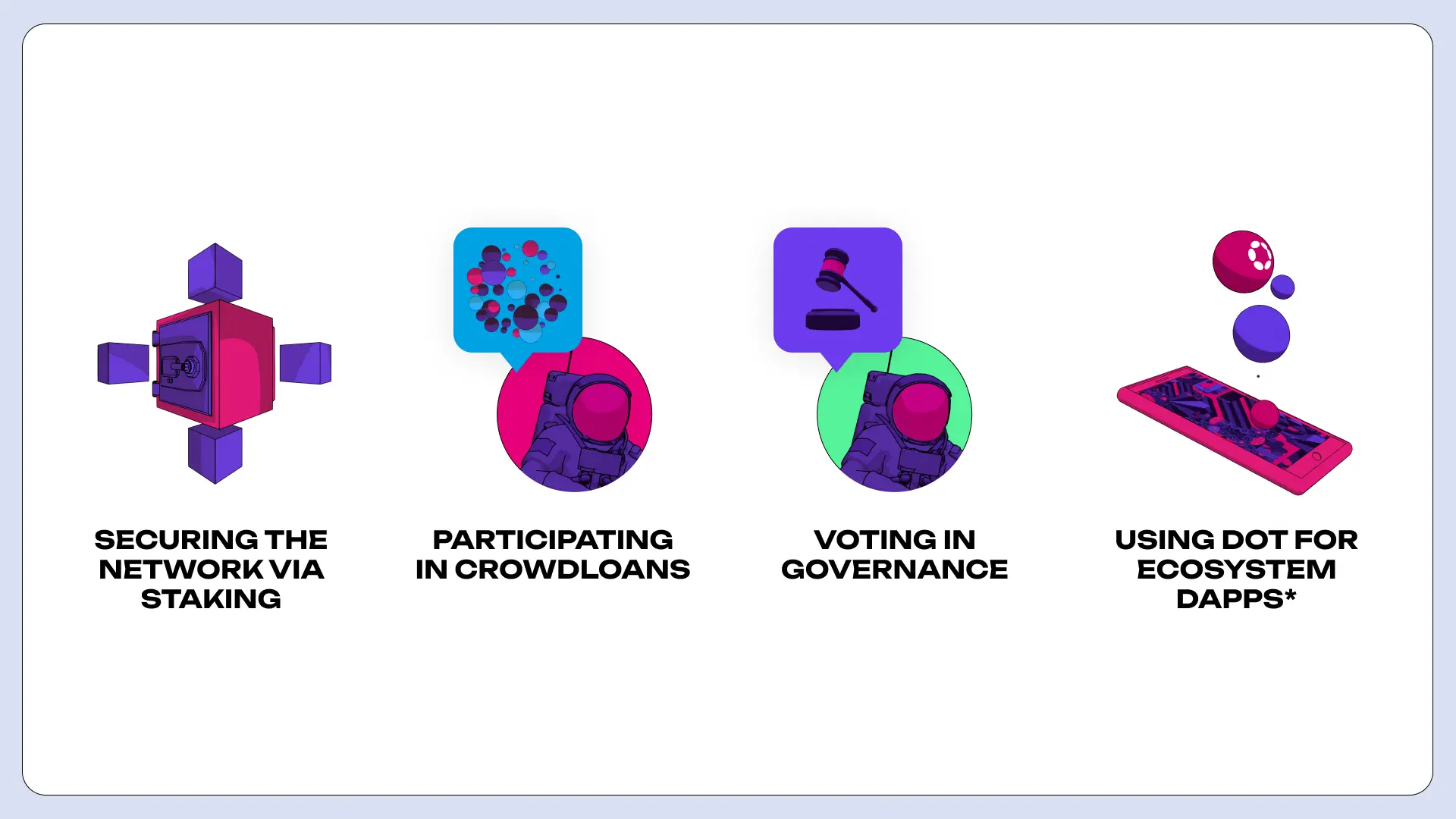Unlocking DOT Opportunities: Staking, Crowdloans, and More
A look at DOT token utility and the different ways DOT can be used in the Polkadot ecosystem.
 By Oliver Brett•October 25, 2023
By Oliver Brett•October 25, 2023
Around two years ago, the first Polkadot parachain slots were secured with the help of crowdloans, a way for DOT holders to support their favorite parachain projects and get rewarded in return, typically with the project’s native token. With the two-year lease period for Polkadot’s first parachains now coming to a close, early crowdloan contributors are set to have their DOT contributions unlocked and free for use.
With this in mind, and as crowdloan contributors consider what to do with their newly unlocked DOT, let’s take a look at token utility and the different ways DOT can be used in the Polkadot ecosystem. From helping secure Polkadot’s Nominated-Proof-of-Stake (NPoS) system to participating in governance, dapps, and crowdloans, Polkadot’s native token has a number of uses that support the network and offer benefits in return.

Staking
Staking DOT natively serves a dual purpose: it helps protect Polkadot from malicious attacks while also supporting the network’s decentralization. Staking on Polkadot also enables DOT holders to collect staking rewards for their service of helping secure the network.
Stakers in Polkadot’s NPoS system are called nominators because they nominate validators to secure the network. Validators play a more technical role of securing the network and participating in consensus and block production.
There are several ways to stake on Polkadot. Native staking, which means staking directly on Polkadot without going through an intermediary, enables you to stay in full control of your DOT and has benefits for the network in terms of security and decentralization. The easiest way to stake natively is to join a nomination pool. DOT holders can join a nomination pool with as little as 1 DOT, and get a more passive staking experience, as they don’t need to select their own validators, monitor validator performance, or regularly update their nominations.
Alternatively, more advanced stakers can nominate directly by selecting their own list of up to 16 validators. This method requires a bit more active engagement, as nominators should research validators, monitor their performance, and periodically update their nominations. Nominating on Polkadot is not without risk, as nominators can lose a portion of their DOT tokens via slashing if they select a malicious validator.
Direct nominators also need to make sure they stake more tokens than the minimum amount required to be an active nominator and receive rewards. This amount is currently around 450 DOT and increases as participation in staking increases. Nominators who are confident in their ability to select trustworthy validators can also open their own nomination pool and allow others to join.
Polkadot’s Staking Dashboard is an easy way to start nominating, directly or by nomination pool. The dashboard supports several Polkadot wallets and provides a simple interface where nominators can manage their nominations, join pools, and optimize their staking rewards. Tutorials for the staking dashboard can be found here.
Several Polkadot wallets also support staking, including Nova Wallet, Talisman, Fearless Wallet and SubWallet. For an overview of Polkadot wallets and their included features, visit the Polkadot wallets page. Cold/hardware wallets are recommended for the highest level of security; hardware wallets currently supported are Ledger and Polkadot Vault.
Several other staking options exist beyond native staking, including staking via third-party custodial services and exchanges. Some Polkadot parachains, including Bifrost, Acala, and Equilibrium, also offer liquid staking features that offer additional capabilities to stakers. DOT holders are recommended to thoroughly research third-party custodial and liquid staking services before participating, as they involve different risks than native staking.
Participating in governance
Polkadot's OpenGov is perhaps the most advanced governance system in Web3. Launched earlier in 2023, it allows anyone with DOT to propose or vote on referenda, and brings greater decentralization than Polkadot’s previous governance system. Along with NPoS, OpenGov is one of the Polkadot features that make it among the most decentralized networks in Web3.
OpenGov provides significant advantages compared with other networks: multiple referenda can run simultaneously, meaning changes can be deployed more rapidly (or in the case of a request for Treasury funds, tokens can be released faster). “Conviction voting” - locking tokens up for longer - helps level the playing field for those with fewer tokens.
DOT holders are encouraged to participate in OpenGov and make their voices heard. Learn about how to participate on the OpenGov page and the Polkadot wiki, and learn how the Treasury works here. Governance proposals are discussed and voted on via governance interfaces such as Polkassembly and Subsquare. Those who don’t have the time or desire to participate actively in governance can delegate their voting power to someone to vote on their behalf. Learn about vote delegation here and try it out via the delegation dashboard.
Several resources exist to keep up to date on governance discussions, including Polkassembly and community channels such as The Kusamarian, the Referendum Roundup, and DotLeap.
Using DOT with Polkadot applications
Polkadot is a rich ecosystem with hundreds of diverse dapps and projects. These cover a wide gamut of use cases, such as gaming, NFTs, DeFi, privacy, smart contracts, ID, data, storage, sustainability, social media and IoT.
Many of the dapps that users may wish to explore support participation via DOT, while others will require using parachain native tokens. Solutions are currently under development to seamlessly use DOT for all ecosystem applications. As always, DOT holders should conduct thorough research before using any applications as they may carry their own risks. To see what dapps are live in the ecosystem, check out this ecosystem page.
Participating in Crowdloans
While the crowdloan model is expected to eventually be phased out with the development of new, more agile ways to allocate Polkadot’s compute resources, some projects may still be conducting crowdloans in the near future that DOT holders can participate in.
Joining crowdloans is a way of supporting early-stage parachains, enabling a much lower barrier of entry than would otherwise be the case. Contributing to a crowdloan involves locking DOT tokens for up to two years (the duration of the parachain’s lease). Parachain teams choose how to reward their contributors for joining their communities, though typically they do this with a portion of their native token. After the parachain’s lease expires (typically two years) all DOT from contributors is unlocked and once again free for use in staking, governance, etc.
It’s important to note that crowdloan participation may involve different risks than other uses of DOT such as staking, as market conditions can change greatly during the period that crowdloan contributions are locked.
DOT is the primary tool for people to interact with, secure, and coordinate the Polkadot network, and has many uses across the ecosystem. Future developments may also bring additional uses for DOT, such as purchases of coretime as part of ongoing proposals for Polkadot’s future roadmap. These and any future upgrades will need to be approved by OpenGov. As a DOT holder, Polkadot gives you a say in how the network is run, giving you an active role in the movement for a better web.











